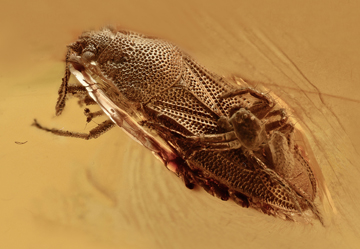Abstract
Stegocoleus Jarzembowski & Wang is an enigmatic genus in the family Ommatidae, known to date only from Burmese amber. This genus possesses a unique combination of characters, including antennal grooves on the ventral side of head, well-developed epipleural rims, and presence of separated procoxae, which makes its systematic position unclear. Here we report two new species of Lepidomma from mid-Cretaceous Burmese amber, L. longisquama sp. nov. and L. jarzembowskii sp. nov. Based on these well-preserved specimens and new morphological details revealed by widefield fluorescence and confocal microscopy, we discuss the morphological similarities between Lepidomma and the enigmatic Stegocoleus. We suggest that Stegocoleus is not a basal ommatid, but a highly derived form of ommatid beetles.
References
Beutel, R.G., Ge, S.Q. & Hörnschemeyer, T. (2008) On the head morphology of Tetraphalerus, the phylogeny of Archostemata and the basal branching events in Coleoptera. Cladistics, 24, 270–298.
https://doi.org/10.1111/j.1096-0031.2007.00186.x
Escalona, H.E., Lawrence, J.F. & Ślipiński, A. (2020) The extant species of the genus Omma Newman and description of Beutelius gen. nov. (Coleoptera: Archostemata: Ommatidae: Ommatinae). Zootaxa, 4728 (4), 547–574.
https://doi.org/10.11646/zootaxa.4728.4.11
Hörnschemeyer, T. (2009) The species-level phylogeny of archostematan beetles—where do Micromalthus debilis and Crowsoniella relicta belong? Systematic Entomology, 34, 533–558.
https://doi.org/10.1111/j.1365-3113.2009.00476.x
Jarzembowski, E.A. & Wang, B. (2016) An unusual basal beetle from Myanmar (Coleoptera: Archostemata). Alcheringa, 40, 297–302.
https://doi.org/10.1080/03115518.2016.1132493
Jarzembowski, E.A., Wang, B. & Zheng, D.R. (2018) A slender new archaic beetle in Burmese amber (Coleoptera: Archostemata). Alcheringa, 42, 110–114.
https://doi.org/10.1080/03115518.2017.1374461
Jarzembowski, E.A., Wang, B. & Zheng, D.R. (2019) A new scaly archaic beetle (Coleoptera: Archostemata) from mid-Cretaceous Burmese amber. Cretaceous Research, 99, 315–320.
https://doi.org/10.1016/j.cretres.2019.02.027
Kirejtshuk, A.G. (2020) Taxonomic review of fossil coleopterous families (Insecta, Coleoptera). Suborder Archostemata: superfamilies Coleopseoidea and Cupedoidea. Geosciences, 10, 73.
https://doi.org/10.3390/geosciences10020073
McKenna, D.D., Wild, A.L., Kanda, K., Bellamy, C.L., Beutel, R.G., Caterino, M.S., Farnum, C.W., Hawks, D.C., Ivie, M.A., Jameson, M.L., Leschen, R.A.B, Marvaldi, A.E., McHugh, J.V., Newton, A.F., Robertson, J.A., Thayer, M.K., Whiting, M.F., Lawrence, J.F., Ślipiński, A., Maddison, D.R. & Farrell, B.D. (2015) The beetle tree of life reveals that Coleoptera survived end-Permian mass extinction to diversify during the Cretaceous terrestrial revolution. Systematic Entomology, 40, 835–880.
https://doi.org/10.1111/syen.12132
McKenna, D.D., Shin, S., Ahrens, D., Balke, M., Beza-Beza, C., Clarke, D.J., Donath, A., Escalona, H.E., Friedrich, F., Letsch, H., Liu, S., Maddison, D., Mayer, C., Misof, B., Murin, P.J., Niehuis, O., Peters, R.S., Podsiadlowski, L., Pohl, H., Scully, E.D., Yan, E.V., Zhou, X., Ślipiński, A. & Beutel, R.G. (2019) The evolution and genomic basis of beetle diversity. Proceedings of the National Academy of Sciences, USA, 116, 24729–24737.
https://doi.org/10.1073/pnas.1909655116
Ponomarenko, A.G. (2000) Beetles of the family Cupedidae from the Lower Cretaceous locality of Semen, Transbaikalia. Paleontological Journal, 34, S317–S322.
Tan, J., Wang, Y., Ren, D. & Yang, X. (2012) New fossil species of ommatids (Coleoptera: Archostemata) from the Middle Mesozoic of China illuminating the phylogeny of Ommatidae. BMC Evolutionary Biology, 12, 113.
https://doi.org/10.1186/1471-2148-12-113
Tihelka, E., Huang, D.Y. & Cai, C.Y. (2020) New data on Ommatidae (Coleoptera) from mid-Cretaceous Burmese amber. Cretaceous Research, 106, 104253.


